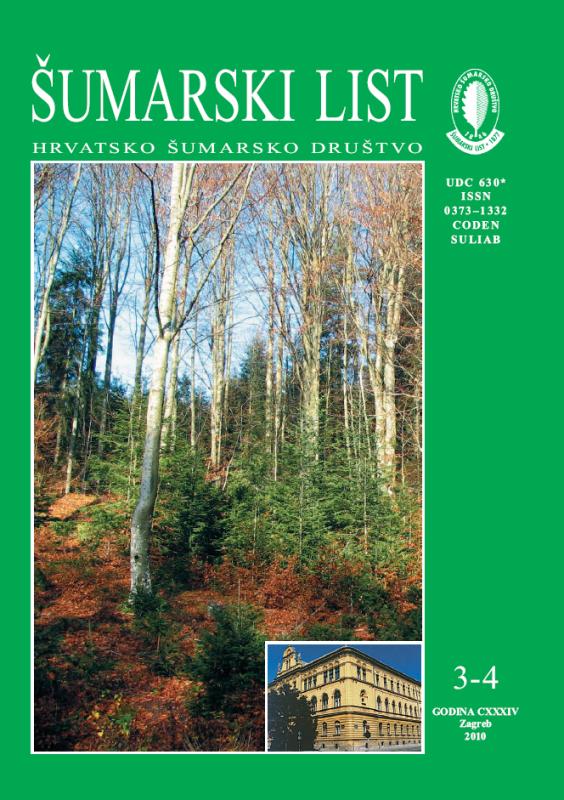
broj: 3-4/2010
pdf (7,3 MB) |
|
||||||||||||||
| RIJEČ GLAVNOGA UREDNIKA | ||
| Branimir Prpić | ||
| FOREST DAY, WORLD WATER DAYANDWORLD METEOROLOGICAL DAY pdf HR EN | 101 | |
| IZVORNI ZNANSTVENI ČLANCI | ||
| Zečić,Ž., D. Vusić, M. Prka, S. Klepac | UDK 630* 377 (001) | |
| Influence of Skidding Road Slope on Productivity of Skidding Timber Assortments with Tractor Timberjack 240C in Selective Forests pdf HR EN | 103 | |
| Ostrogović, M.Z., K. Sever, I.Anić | UDK 630* 231 (001) | |
| Influence of Light on Natural Regeneration of Pedunculate Oak (Quercus roburL.) in the Maksimir Forest Park in Zagreb pdf HR EN | 115 | |
| Jambreković,V., R. Despot, M. Hasan | UDK 630* 841 (001) | |
| The Overview and Evaluation of Phytosanitary System in CompaniesAuthorised for the Treatment and Marking of Wooden Material for Packaging in International Trade pdf HR EN | 125 | |
| Pezdevšek Malovrh, Š., L. Zadnik Stirn, J. Krč | UDK 630* 682 (001) | |
| Influence of Ownership and Property Structure on Willingness of Private Forest Owners to Cooperate pdf HR EN | 139 | |
| STRUČNI ČLANCI | ||
| Posarić, Darko | UDK 630* 440 + 450 | |
| The most Important Reasons for the Loss of Pedunculate Oak (Quercus roburL.) from Forest Stands up to First Thinnings pdf HR EN | 151 | |
| Summary: During the process of natural regeneration of pedunculate oak (Quercus roburL.) forests, and later during a growth of young plants, up to the age of approximately 20 years of old, many oak plants die out. This paper will not deal with those oak trees which, in the struggle for light with other oak plants die during the growth of the stand. This is a normal, natural process. Paper will deal with the reasons for excessive loss of oak plants and disruption of the normal tree species ratio in lowland oak forests and ways to prevent these losses. Many unfavorable factors are causing a decline of oak plants. Their sequencing and/or synergic action is a reason that many oak plants die out. If the natural regeneration of the stand is well managed, and if the adverse impacts are controlled all the time to the first thinnings, it is very likely that there will be a high quality oak stand. However, if the foresters come too late with the protection of the stand at any stage of its growth, or even fails to do it, oak plants suffer. It is therefore very important to protect and tending young stand well up to the age of the first thinnings. The adverse impacts that endanger oak plants are numerous and diverse. The most harmful are retaining surface water, small forest rodents (especially vole species – Figure 4) and competitive weed vegetation (Figures 3 and 5). Some influences are under the permanent supervision and there is a quality protection against them (e.g. Oak mildew – Microsphaera alphitoidesGriff. et Maubl.) and because of that they are not causing much damage, although they are potentially very dangerous. Some others are underestimated and therefore their harmful impact occurs, especially after the removal of the old stand by final cut, when monitoring and control of the young stand are not so intensive as they were during the regeneration process. A need for permanent professional supervision and control of the stands state is the most important conclusion of this work, because they are a prerequisite for timely and proper response to the observed adverse impacts. Keywords: the die out of oak plants, seedling stage, sapling stage, young forest, prop stage, retaining surface water, small rodents, vegetation of weeds, monitoring the situation of stands. | ||
| Ivančević, Vice | UDK 630* 902 | |
| The Rich Museum Tradition of Croatian Forestry Continues - On the occasion of opening the Forestry Museum in Krasno, the first in our country pdf HR EN | 159 | |
| Roša, Jadranka | UDK 630* 892 | |
| Steps to the Eco-label for Therapeutical Herbs andAromatic Plants pdf HR EN | 169 | |


